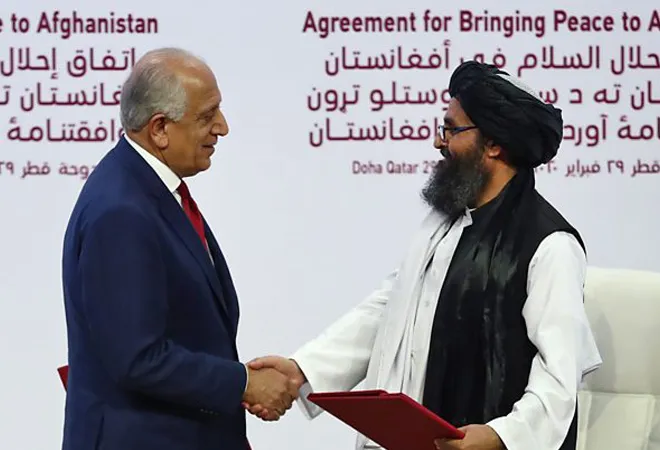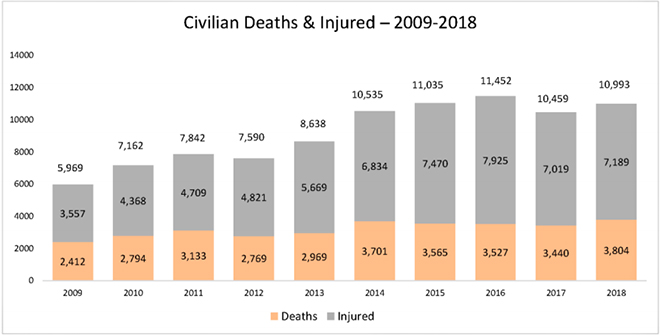
The latest round of talks between the Taliban and US negotiators led by Special Envoy Zalmay Khalilzad, which took place at an undisclosed location in Doha, ended on 12 March, 2019. Despite the 16-day long marathon negotiations, no major breakthrough was achieved, barring some “progress” on two fronts: US troop withdrawal from Afghanistan, and a Taliban guarantee supporting the prohibition on the use of Afghan territory to devise terrorist attacks against the US, by indigenous and foreign terror outfits alike. Deliberations on the specifics of a potential peace deal, however, albeit limited and vague, have failed to turn over a new leaf in an environment of ever-increasing volatility in Afghanistan. Even as negotiations were taking place between the US and Taliban representatives in Qatar, Afghanistan witnessed an intensification of violence at the hands of the Taliban, aimed primarily at the national security apparatus.
Even as negotiations were taking place between the US and Taliban representatives in Qatar, Afghanistan witnessed an intensification of violence at the hands of the Taliban, aimed primarily at the national security apparatus.
As recently as on 17 March, 2019, soon after the latest round of talks ended, news arrived of the Taliban routing a company of the Afghan National Army in the western district of Bala Murghab, in the Badghis province, and essentially chased them into Turkmenistan. Blocking all roads and routes leading to the long-contested district of Bala Murghab, the Taliban reached the district centre in no time, overrunning 11 security posts and in the process, defeating the unit of the Afghan Border Force stationed there, which is an arm of the Afghan National Army. Although the administration of Turkmenistan was reported to have decided to return the 100 odd Afghan soldiers to the Taliban, and the weaponry of the soldiers to the Afghan government, the Taliban is said to have asked for the opposite: weapons instead of the soldiers.
The most striking feature of the attack was the hitherto minimal influence of the Taliban over Badghis, and therefore their capacity for rapid geographical expansion of control over Afghan districts. Although the Taliban have been contesting the control of the district of Bala Murghab for three years now, Badghis Province is not known to be one of their strongholds. Even as Uruzgan, Kunduz and Helmand are understood to be the core constituencies of the insurgent group, the Taliban’s ability to seize control of Bala Murghab in a matter of weeks,, is cause for alarm. Another point worth noting about the confrontation is that the 2,500 Taliban insurgents were far better equipped than the Afghan forces battling them, armed with laser technology weapons and night vision goggles, as stated by a local commander of the Afghan police force. Although the Afghan government often attributes the failure of its forces to the alleged possession of superior weapons by the Taliban, and the formidable number of the insurgent group, it certainly raises questions about the ineptitude of the Afghan National Army in successfully combatting Taliban assaults, or even accurately detecting insurgent mobilization of such magnitude.
Another major insurgent attack took place on 1 March, 2019, on the eve of the beginning of the Doha peace talks, after a break of two days, in which 8 Taliban suicide bombers and other insurgents penetrated the Afghan military compound of Camp Shorab in Helmand Province, and inflicted massive casualties. American Special Forces soldiers, who are tasked with training the Afghan army were also said to be stationed in a compound within the base, and therefore were party to the confrontation. However, an American military spokesperson in Kabul, Col. Dave Butler stated that there were no American causalities. Among the Afghan forces, however, the number of casualties was as high as 44, as per reports.
Multiple clashes between the Taliban and US/NATO forces stationed in Afghanistan, which took place in the face of peace negotiations, resulting in a significantly large civilian and military death toll in the country, is indicative of the strategy being pursued by both, the US as well as Taliban representatives engaging in talks, to secure their respective objective. The strategy, seems to be one of inflicting violence on each other on the ground, to build diplomatic leverage that can be utilized to manipulate the trajectory, and effectively the verdict of the peace process, in their favour. The recent US airstrike on an Afghan National Army base in the Uruzgan province, although claimed to have been initiated in reaction to a supposed attack by a unit of the Afghan army on a joint convoy of Afghan Special Forces and American troops, seems to have exacerbated tensions between all stakeholders in the conflict.
The strategy, seems to be one of inflicting violence on each other on the ground, to build diplomatic leverage that can be utilized to manipulate the trajectory, and effectively the verdict of the peace process, in their favour.
On the other hand, ongoing violence in Afghanistan at the hands of anti-government forces, primarily initiated by the Taliban, may also be due to a degree of internal strife within the insurgent group. The fact that the Taliban have never been a “monolithic” entity, which has translated into the moderates lacking considerable political capital to effect changes within the structure and ideological leanings of the organization, the possibility of a section of the Taliban not in favour negotiating peace may be real. The hardliners at home may be at odds with the “political” leadership of the Taliban talking settlement with US Special Envoy Khalilzad in Doha. Moreover, there are questions regarding the credibility of Mullah Baradar as the chief negotiator and a senior leader of the Taliban, given that he was incarcerated by the Pakistani Inter-Services Intelligence (ISI) for eight years, for establishing contacts with the then Afghan government in an independent capacity. The lack of a centralizing authority in the Taliban could potentially explain the inability of the leadership of the group to ensure coherence and consistency in decisions and actions. The continuation of violence on the ground therefore is reflective of an absence of any sign of good faith on the part of the Taliban, and overarching influence over insurgent cadres.
The continuation of violence on the ground therefore is reflective of an absence of any sign of good faith on the part of the Taliban, and overarching influence over insurgent cadres.
Regardless of factors such as the need to build diplomatic leverage to swing the verdict of the peace process in their favour, and the possibility of internal strife within the group fueling acts of violence in Afghanistan, the Taliban need to be understood first and foremost as an ideologically driven movement, using the ‘righteousness’ of jihad to further their objectives. With or without a peace deal in hand, the Taliban are likely to continue waging a war against government forces on the domestic front, pledges and guarantees notwithstanding. Having said that, it is the common Afghan that has lost the most in terms of institutions of community building, and the basic human right to a life of dignity. According to a report published by the United Nations, civilian casualties reached a record high of 3,804 in 2018, which comprised of 927 children among those that fell prey to the havoc wrecked by insurgent forces and pro-government troops in Afghanistan, showcasing a trend of “deliberate targeting of civilians” by the insurgents.
 Source: UN Report
Source: UN Report
The new generation of Afghans, however, are unlikely to accept the atrocities committed by the Taliban, a claim that is bolstered by the results of a recent survey, conducted to gauge popular support for the Taliban. As per the findings of the survey, 82.4% of the participants proclaimed that they were not hospitable or even sympathetic to the Taliban. That said, the Taliban undoubtedly are vying to wield a significant share of political power in the country, and to that extent, will leave no stone unturned to achieve their political and ideological/theological objectives. The premise for the creation of the Taliban, and their staunch belief in a radical Islamic ideology, will eventually render their promises to “treat all Afghans like brothers” to reach, and subsequently execute a peace deal, shallow and fallacious.
The views expressed above belong to the author(s). ORF research and analyses now available on Telegram! Click here to access our curated content — blogs, longforms and interviews.




 Source:
Source:  PREV
PREV


